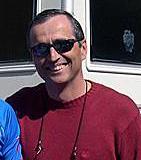
Recently on Cyclingnews.com |
 |
Doctor's orders: The Dr Michele Ferrari Journal
Dr Michele Ferrari, coach to cycling greats including Moser, Bugno, Argentin and Rominger, in addition to five-time Tour de France winner and defending champion Lance Armstrong, has never been afraid to push the boundaries of sports science.
In 2004, cycling's most controversial sports doctor will once again provide Cyclingnews readers with his unique insight into the mindset of what makes or breaks a champion.
Critérium du Dauphiné Libéré, Stage 4 - June 10: Bédoin - Le Mont Ventoux ITT, 21.6 km
Mediations on Mont Ventoux
Mont Ventoux: a mysterious and fascinating mountain.
In the 14th century, the Italian poet Francesco Petrarca stayed on top of Ventoux for some days of deep meditation, fascinated by the majesty of the landscape or maybe in need of some proper recovery after the hard climb, not so comfortable for those times.
This year, the Dauphiné uphill time trial on Ventoux (21.6 km, 1620 m of difference in altitude) did bring forward some interesting results, as usual, and even some surprises.
In the hardest part of the ascent (9.8 km at 9.2 percent gradient), Mayo and Hamilton expressed a VAM of 1860 m/h; Armstrong made 1810 m/h (difference of 2.7 percent). Not considering the influence of the wind (somehow always present on this climb), and guessing a body weight of 60 kg for Mayo and Hamilton, both of them were able to push on this distance a power output of about 370-380 watts, while Lance (75 kg) generated approximately 450-460 watts.
Mayo's, Hamilton's, and even Sevilla's performances are comparable to those of the best climbers of recent years (Pantani, Gotti, Simoni, Heras), while Armstrong repeated exactly the same performance he made in 1999 Dauphiné, on the same course.
Charlie Gaul, one of the greatest climbers of all time, scored a time of 1h02'09" (1576 m/h) at Mont Ventoux in 1959. Mayo's time (55'51" a 1750 m/h) expresses an 11 percent higher power.
Let's keep in mind that bicycles back then weighed about 3 kg more than nowadays, reducing the difference down to 6.8 percent (3 kg represent 4.2 percent of the total weight of rider and bike, that we can estimate around 70 kg).
Interesting to note: some days ago, Ethiopian Kenesisa Bekele was able to run 10000 m in 26'20" (22.78 km/h), setting a new world record. In Gaul's time, the record at that distance (held by Russian Piotr Bolotnikov) was 28'18". A difference then of 7.4 percent, not so far from the 6.8 percent that separates Mayo's from Gaul's performances on Ventoux."
